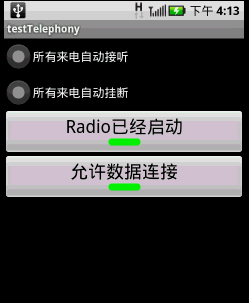上次介绍了如何使用JAVA的反射机制来调用蓝牙的隐藏API,这次继续练习JAVA的反射机制,探秘TelephonyManager在Framework里包含却在SDK隐藏的几项功能。先来看看本文程序运行的效果图:

本文程序演示了以下功能:
1.所有来电自动接听;
2.所有来电自动挂断;
3.开启/关闭Radio;
4.开启/关闭数据连接(WAP or NET的连接)。
调用TelephonyManager的隐藏API是先参考Framework的/base/telephony/java/com/android/internal/telephony/ITelephony.aidl,然后自己实现一个ITelephony.aidl,最后在TelephonyManager中通过反射机制实例化自定义的ITelephony,实例化之后就可以调用ITelephony里面的函数了。
本文程序需要在AndroidManifest.xml添加以下两行代码,以获得权限:
- <uses-permission android:name="android.permission.CALL_PHONE" />
- <uses-permission android:name="android.permission.MODIFY_PHONE_STATE" />
main.xml源码如下:
- <?xml version="1.0" encoding="utf-8"?>
- <LinearLayout xmlns:android="http://schemas.android.com/apk/res/android"
- android:orientation="vertical" android:layout_width="fill_parent"
- android:layout_height="fill_parent">
- <RadioGroup android:layout_height="wrap_content"
- android:layout_width="fill_parent" android:id="@+id/rGrpSelect">
- <RadioButton android:layout_height="wrap_content"
- android:layout_width="fill_parent" android:id="@+id/rbtnAutoAccept"
- android:text="所有来电自动接听"></RadioButton>
- <RadioButton android:layout_height="wrap_content"
- android:layout_width="fill_parent" android:id="@+id/rbtnAutoReject"
- android:text="所有来电自动挂断"></RadioButton>
- </RadioGroup>
- <ToggleButton android:layout_height="wrap_content"
- android:layout_width="fill_parent" android:id="@+id/tbtnRadioSwitch"
- android:textOn="Radio已经启动" android:textOff="Radio已经关闭"
- android:textSize="24dip" android:textStyle="normal"></ToggleButton>
- <ToggleButton android:layout_height="wrap_content"
- android:layout_width="fill_parent" android:id="@+id/tbtnDataConn"
- android:textSize="24dip" android:textStyle="normal" android:textOn="允许数据连接"
- android:textOff="禁止数据连接"></ToggleButton>
- </LinearLayout>
PhoneUtils.java是手机功能类,从TelephonyManager中实例化ITelephony并返回,源码如下:
- package com.testTelephony;
- import java.lang.reflect.Field;
- import java.lang.reflect.Method;
- import com.android.internal.telephony.ITelephony;
- import android.telephony.TelephonyManager;
- import android.util.Log;
- public class PhoneUtils {
- /**
- * 从TelephonyManager中实例化ITelephony,并返回
- */
- static public ITelephony getITelephony(TelephonyManager telMgr) throws Exception {
- Method getITelephonyMethod = telMgr.getClass().getDeclaredMethod("getITelephony");
- getITelephonyMethod.setAccessible(true);//私有化函数也能使用
- return (ITelephony)getITelephonyMethod.invoke(telMgr);
- }
- static public void printAllInform(Class clsShow) {
- try {
- // 取得所有方法
- Method[] hideMethod = clsShow.getDeclaredMethods();
- int i = 0;
- for (; i < hideMethod.length; i++) {
- Log.e("method name", hideMethod[i].getName());
- }
- // 取得所有常量
- Field[] allFields = clsShow.getFields();
- for (i = 0; i < allFields.length; i++) {
- Log.e("Field name", allFields[i].getName());
- }
- } catch (SecurityException e) {
- // throw new RuntimeException(e.getMessage());
- e.printStackTrace();
- } catch (IllegalArgumentException e) {
- // throw new RuntimeException(e.getMessage());
- e.printStackTrace();
- } catch (Exception e) {
- // TODO Auto-generated catch block
- e.printStackTrace();
- }
- }
- }
testTelephony.java是主类,使用PhoneStateListener监听通话状态,以及实现上述4种电话控制功能,源码如下:
- package com.testTelephony;
- import android.app.Activity;
- import android.os.Bundle;
- import android.telephony.PhoneStateListener;
- import android.telephony.TelephonyManager;
- import android.util.Log;
- import android.view.View;
- import android.widget.RadioGroup;
- import android.widget.ToggleButton;
- public class testTelephony extends Activity {
- /** Called when the activity is first created. */
- RadioGroup rg;//来电操作单选框
- ToggleButton tbtnRadioSwitch;//Radio开关
- ToggleButton tbtnDataConn;//数据连接的开关
- TelephonyManager telMgr;
- CallStateListener stateListner;
- int checkedId=0;
- @Override
- public void onCreate(Bundle savedInstanceState) {
- super.onCreate(savedInstanceState);
- setContentView(R.layout.main);
- telMgr= (TelephonyManager)getSystemService(TELEPHONY_SERVICE);
- telMgr.listen(new CallStateListener(), CallStateListener.LISTEN_CALL_STATE);
- PhoneUtils.printAllInform(TelephonyManager.class);
- rg = (RadioGroup)findViewById(R.id.rGrpSelect);
- rg.setOnCheckedChangeListener(new CheckEvent());
- tbtnRadioSwitch=(ToggleButton)this.findViewById(R.id.tbtnRadioSwitch);
- tbtnRadioSwitch.setOnClickListener(new ClickEvent());
- try {
- tbtnRadioSwitch.setChecked(PhoneUtils.getITelephony(telMgr).isRadioOn());
- } catch (Exception e) {
- Log.e("error",e.getMessage());
- }
- tbtnDataConn=(ToggleButton)this.findViewById(R.id.tbtnDataConn);
- tbtnDataConn.setOnClickListener(new ClickEvent());
- try {
- tbtnDataConn.setChecked(PhoneUtils.getITelephony(telMgr).isDataConnectivityPossible());
- } catch (Exception e) {
- Log.e("error",e.getMessage());
- }
- }
- /**
- * 来电时的操作
- * @author GV
- *
- */
- public class CheckEvent implements RadioGroup.OnCheckedChangeListener{
- @Override
- public void onCheckedChanged(RadioGroup group, int checkedId) {
- testTelephony.this.checkedId=checkedId;
- }
- }
- /**
- * Radio和数据连接的开关
- * @author GV
- *
- */
- public class ClickEvent implements View.OnClickListener{
- @Override
- public void onClick(View v) {
- if (v == tbtnRadioSwitch) {
- try {
- PhoneUtils.getITelephony(telMgr).setRadio(tbtnRadioSwitch.isChecked());
- } catch (Exception e) {
- Log.e("error", e.getMessage());
- }
- }
- else if(v==tbtnDataConn){
- try {
- if(tbtnDataConn.isChecked())
- PhoneUtils.getITelephony(telMgr).enableDataConnectivity();
- else if(!tbtnDataConn.isChecked())
- PhoneUtils.getITelephony(telMgr).disableDataConnectivity();
- } catch (Exception e) {
- Log.e("error", e.getMessage());
- }
- }
- }
- }
- /**
- * 监视电话状态
- * @author GV
- *
- */
- public class CallStateListener extends PhoneStateListener {
- @Override
- public void onCallStateChanged(int state, String incomingNumber) {
- if(state==TelephonyManager.CALL_STATE_IDLE)//挂断
- {
- Log.e("IDLE",incomingNumber);
- }
- else if(state==TelephonyManager.CALL_STATE_OFFHOOK)//接听
- {
- Log.e("OFFHOOK",incomingNumber);
- }
- else if(state==TelephonyManager.CALL_STATE_RINGING)//来电
- {
- if(testTelephony.this.checkedId==R.id.rbtnAutoAccept)
- {
- try {
- //需要<uses-permission android:name="android.permission.MODIFY_PHONE_STATE" />
- PhoneUtils.getITelephony(telMgr).silenceRinger();//静铃
- PhoneUtils.getITelephony(telMgr).answerRingingCall();//自动接听
- } catch (Exception e) {
- Log.e("error",e.getMessage());
- }
- }
- else if(testTelephony.this.checkedId==R.id.rbtnAutoReject)
- {
- try {
- PhoneUtils.getITelephony(telMgr).endCall();//挂断
- PhoneUtils.getITelephony(telMgr).cancelMissedCallsNotification();//取消未接显示
- } catch (Exception e) {
- Log.e("error",e.getMessage());
- }
- }
- }
- super.onCallStateChanged(state, incomingNumber);
- }
- }
- }


发表评论:
◎欢迎参与讨论,请在这里发表您的看法、交流您的观点。